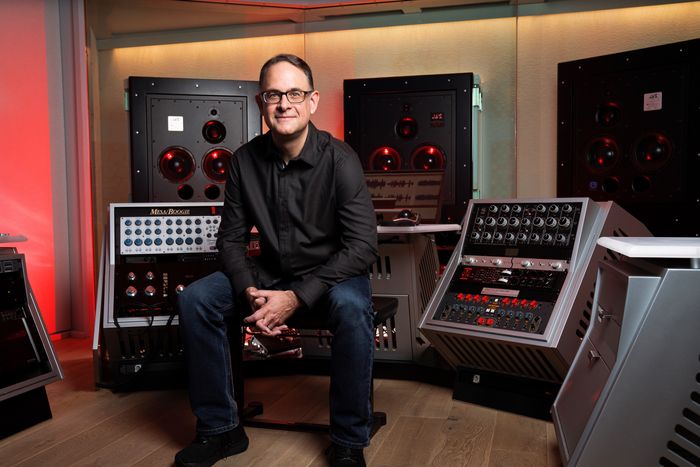
When it came to voting for this year’s Grammy winners, Randy Merrill had some especially hard choices in front of him. Generally, top nominees have no trouble selecting their own work, but in 2023, the 48-year-old mastering engineer was up against himself three separate times in Album of the Year (Adele’s 30, Coldplay’s Music of the Spheres, and Harry Styles’s Harry’s House) and twice in Record of the Year (Adele’s “Easy on Me” and Styles’s “As It Was”). By now, Merrill is used to the accolades — this is his fourth time with multiple AOTY nominations in a single year — even if casting a vote doesn’t get any easier. “I’m super-blessed and very, very grateful to all the people who trust me with their work,” he says from Sterling Sound, the New Jersey studio where he works. “I don’t take that lightly as a mastering engineer. They can really go to anybody.”
A mastering engineer is the final unsung hero of the recording process, often the last person to work on a song or an album before it’s released. While a mixing engineer adjusts the individual elements of the music, equalizing and balancing every instrument and vocal track separately, it’s up to the mastering engineer to tackle all of those elements combined, making sure the full track sounds good on any format (like streaming or vinyl) and from any source (like car speakers, earbuds, or a home stereo). Merrill compares the process to photo editing. “You want to touch the photo up a little bit — you might crop the photo, you might adjust the color balance or the brightness or contrast,” he says. “That’s basically what I do with sound.” The practice requires a precise, exacting ear with an intuitive sense for “what a finished song should sound like.” A full album often takes him a ten-to-12-hour day to master before he then works with a producer, and sometimes the artist themself, to refine his work. Occasionally, this occurs with just a few days’ notice, such as when a secretive new Taylor Swift or Adele project comes in. Mostly, Merrill tries to take the work that the musicians, producers, and mixers have already done and “bring it to life according to how they want it to sound in the end.”
It’s an approach that has paid off, leading Merrill, before this year, to six Grammy wins, including two in Best Engineered Album for his work with Beck. (He’s up in that category again this year, for Harry’s House.) While that is credited, first and foremost, to Merrill’s talent, it’s also a testament to the progress the Grammys have made in recognizing below-the-line technicians, after including mastering engineers on Record of the Year only since 2013. Below, Merrill breaks down his approach to five recent artists he has worked with, from how he makes Adele’s voice shine to what’s different about mastering Swift’s rerecording projects.
With Adele, focus on (what else?) the vocals
“Even more attention is paid to her voice, if it’s possible to pay more attention to it. On 25, I really worked to dial in the vocal sound and bring the song as a whole to the best place possible, where you get the sense of the emotion of the song through the lyrics and sound of it. It’s not something I could do in just five minutes. I’ll probably spend between 45 to 60 minutes per song (sometimes more if I have to) to really milk the best out of the whole thing. What would be involved in that is trying to understand what the song’s about, helping that to be expressed in a way that is musical; how to help it to feel like a performance rather than just a recording; trying to give a sense of intimacy but a sense of dynamics at the same time. It might be through some dynamic management. It might be through a little bit of EQ to try to help each line that she’s singing have a feel to it both sonically and dynamically.”
Everyone’s perspective counts for Coldplay
“I did a lot of the mastering on ‘Coloratura’ up front. Then, the second day, Max Martin came in, and then, the third day, Chris [Martin] came in by himself, and then, the fourth day, the rest of the band — everybody was there listening and making sure everything was the way they wanted it to translate.
Really, by that point, the adjustments were pretty minor. There was one song, ‘Coloratura,’ that Chris just wanted different, that Max and I had listened to on the second day. Every person involved has a different perspective on it. Max, he’s listening to everything. Chris, as a songwriter and a vocalist, he’s listening more to his voice. I think he said he wanted his voice to sound a little smoother, and so what I ended up doing with it was backing off the volume of the whole thing just a little bit — maybe even a little bit of midrange EQ was used as well. Usually what happens is when somebody comes back for a revision, I’ll listen to what they say and then I change my mind-set while I’m listening to the song.”
At Harry’s House, “just stay out of the way”
“That album was pretty straightforward. The mix that came in sounded really good. My part of it was really just to bring a bit of continuity to it, and make sure that all of those little elements are easily heard, and make sure his vocal sounds great. That’s a lot of what mastering is about: knowing how much or how little to do. A lot of engineers may want to put their own sonic thumbprint or signature on it. I tend to not be like that. I let the mix and the music be translated as best as it can, highlighting all the good stuff about it and maybe hiding anything irritating about it sonically.
There’s a bit of room for some creative touches, which is really the fun part of the job for me — the creative things that we can do rather than trying to fix a problem (small EQ changes to highlight something or picking the best transfer method, whether it be the slightest bit of coloration or the lack thereof). On the song ‘Cinema,’ we got to play with a bit of midrange EQ to make it a little richer and a little more luxurious in the vocals. My little bits and pieces of things that I did are audible to me — and I think to the people who worked on it. I’m not sure how audible it is to the average listener, but that’s the fun part to me, too: taking something that’s good already and finding that cool little subtlety that just takes it up a notch.”
Yes, Taylor Swift’s rerecorded albums sound better
“I’m constantly referencing the original version to make sure that the new version sounds better. And most of the time, that happens somewhat naturally in her recording process. Her voice sounds incredible these days. Not that it didn’t sound good when she was younger, but her voice has grown and matured, and I feel like she sings these songs even better than she did originally. So a lot of the sonics of these new recordings just simply have to do with her voice sounding better through age and experience. And as far as the mastering end goes, I’m constantly comparing it to the old versions. The main thing I’m listening to is that the new ones are competitive loudness-wise with the old ones. Pretty much 99 percent of the time, the mix is already well competitive with the volume of the original recordings.”
Beck is “another level” of involved in engineering
“He’s very particular about how he wants things to sound at the end of it. Not that other people aren’t, but I would say he might be another level — it takes a while for him to be satisfied with how something sounds. He’s constantly comparing different versions, trying to find the best combination of all things that he’s trying to go for. Sometimes that involves a mix change, and sometimes it’s a mastering change. Sometimes we’re editing between different versions of mixes and mastering. He wants to hear all the little minutiae in the arrangement and in the song because the arrangements are usually very dense and very detailed. Only he knows how he wants it to turn out, and we as engineers just do our best to guess. That’s why there’s such a back-and-forth — because it’s like looking through a camera. Every step of the way is moving the lens until it’s in focus.”



